本文由 CEBRA 授权mooool发表,欢迎转发,禁止以mooool编辑版本转载。
Thanks CEBRA for authorizing the publication of the project on mooool, Text description provided by CEBRA.
CEBRA Architecture:埃尔霍森(Al Hosn)总体规划项目由丹麦设计工作室CEBRA进行设计开发,出色的总体设计和景观建筑使该项目在过去几年内获得多个国际建筑大奖,而近期更是同时斩获2021届世界建筑新闻网奖 WAN Awards (World Architecture News Awards)和2021世界建筑节奖 WAF Award (World Architecture Festival)。
CEBRA Architecture:The Al Hosn masterplan project in Abu Dhabi, designed and developed by Danish CEBRA, has received several international architecture awards over the last few years – most recently the project has been awarded both WAN Award 2021 and WAF Award 2021 for its overall masterplan design and landscape architecture.
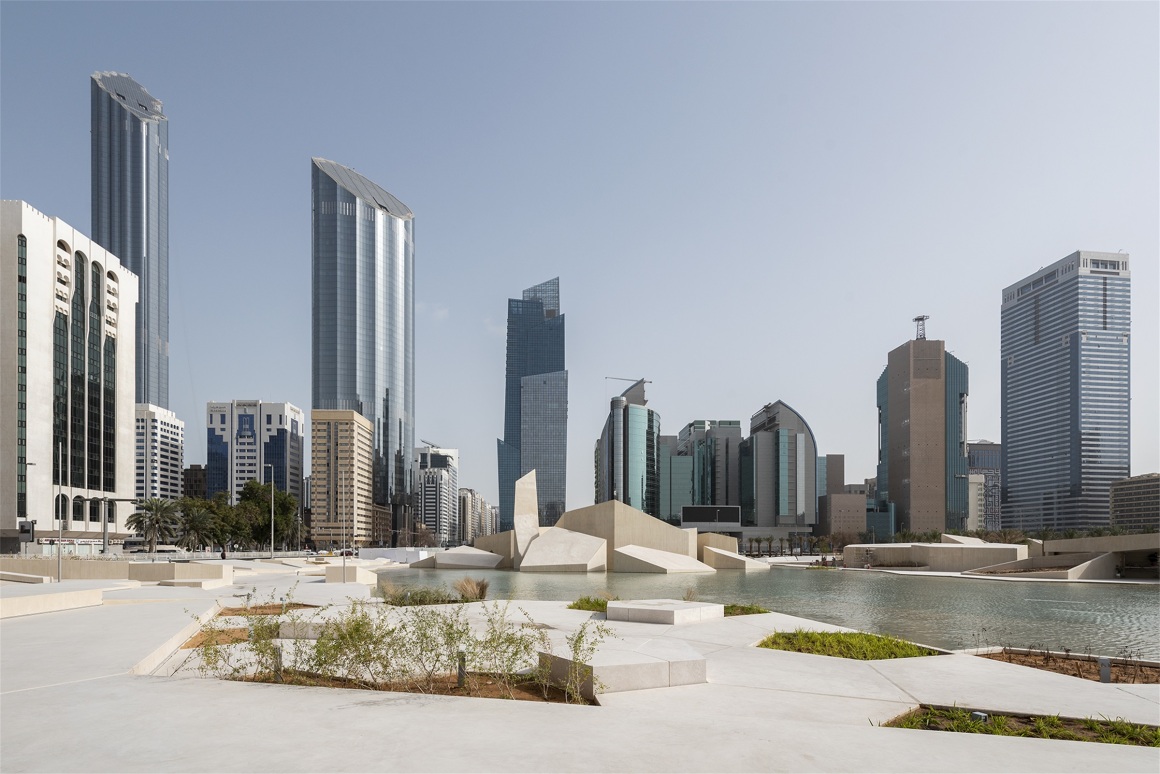
通往未来的奇幻入口 A magical portal to a future inspired by the past
2016年,阿布扎比文化和旅游部门委托丹麦建筑和设计工作室CEBRA重建阿布扎比文化中心埃尔霍森堡。埃尔霍森堡始建于1760年,是这座城市最古老、最重要的建筑,它最初是一座为保护阿布扎比岛上唯一淡水井而建的水塔,后来扩建成为宫殿,随着时代的发展成为现代都市的发源地。
In 2016 the Danish architecture and design practice CEBRA was commissioned by the Department of Culture and Tourism Abu Dhabi to reinstate the Qasr al Hosn Fort as Abu Dhabi’s cultural heart. The Qasr Al Hosn is the city’s oldest and most important building. Originally built in 1760 as a watchtower to protect the only freshwater well on Abu Dhabi Island and later extended into a palace, it literally constitutes the birthplace of the modern metropolis.

这次项目改造的目标是新建一个140000平方米的文化公园景观和保护历史建筑和文化基金会周围的遗址,将1980年被列为A级包豪斯发源地的堡垒重建为城市的文化中心。项目结合源于当地的新型城市景观,将现代主义与阿联酋的海洋和沙漠紧密相连,以连贯的叙事方式表达该场地两栋风格迥异的建筑。
The aim of the transformation masterplan has been to reinstate the fort as the cultural heart of the city with a new 140,000 sqm cultural park-scape and to conserve both the site surrounding the fort and the city’s Cultural Foundation – a 1980’s listed cultural centre of Bauhaus origins – which also sits on the site. Introducing a new type of locally rooted urban landscape the project combines modernity alongside the Emirate’s maritime and desert heritage in a coherent narrative that communicates between the site’s two contrasting buildings.


现如今场地被改造成了一个充满活力的公园,丰富了这两座城市地标性的历史建筑。同时,该项目赋予了场地新的功能:餐馆、文化活动设施、雄伟的祈祷大厅以及水景和遮荫口袋空间兼具的开放景观,这些都是阿布扎比市宝贵的财富。
Today the site is transformed into a vivid public park, which enhances the two historic buildings as important landmarks in the city. Simultaneously, the project adds several new functions to the Al Hosn site making it an asset to the entire city of Abu Dhabi – restaurants, facilities for cultural activities, a breath-taking prayer hall, and an impressive open landscape with water features and shady pocket spaces for relaxation in the Middle Eastern sun.
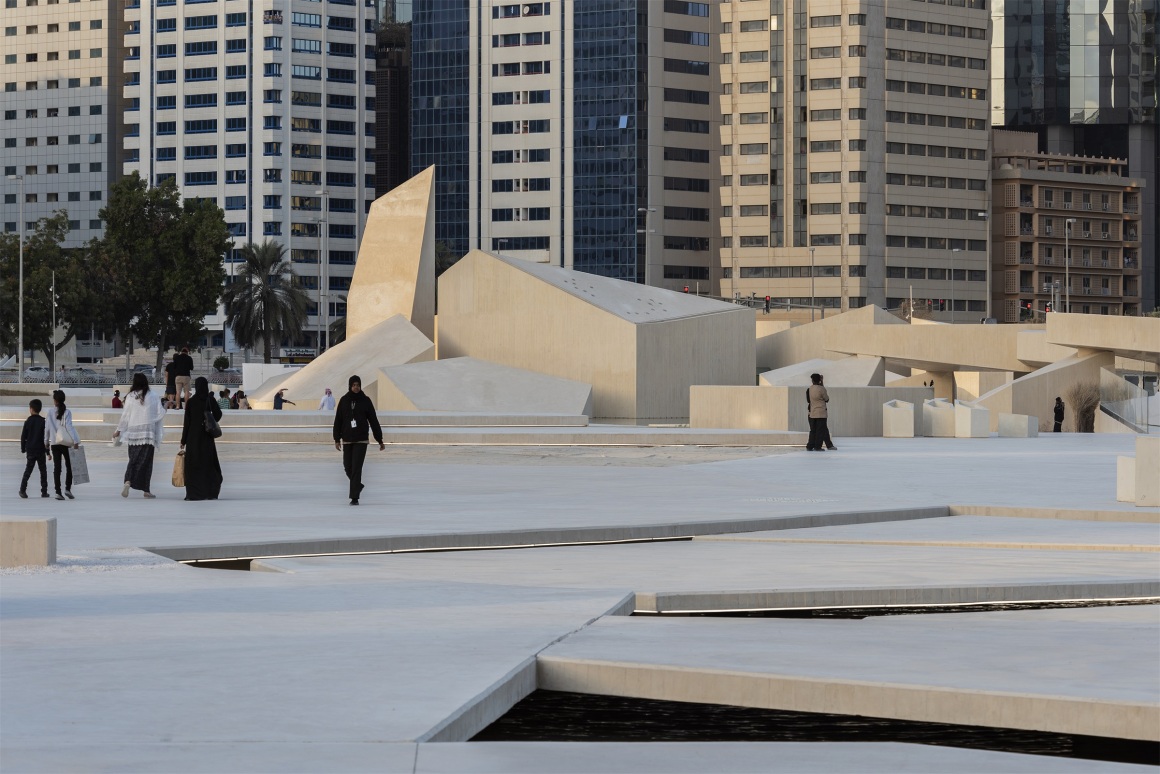
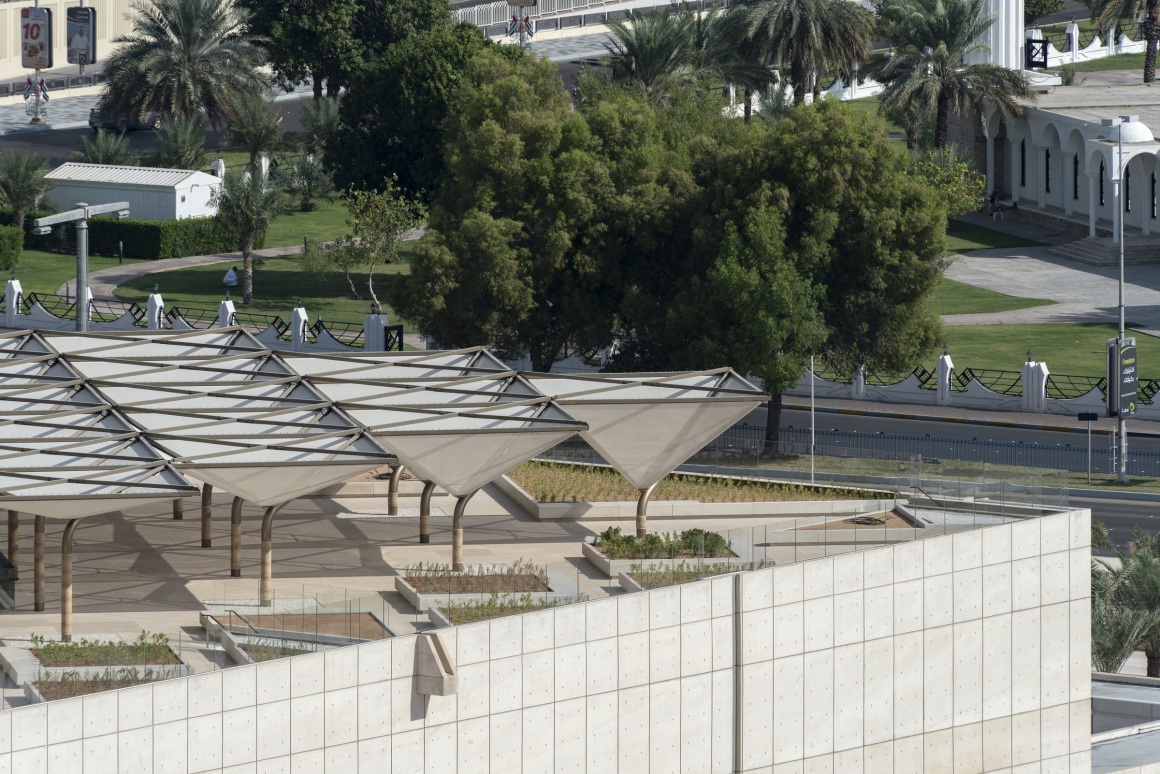
重新引入海岸沙漠景观 REINTRODUCING THE COASTAL DESERT LANDSCAPE
项目通过将场地对角划分为两个对比鲜明的景观来强调自身的双重性。古堡周围平坦和开放的沙漠般的景观呼应这座建筑,使其成为城市的独立地标,就像在现代城市崛起之前的地位一样。与之相对的是,文化基金会周围铺装、规划并强化种植区域,将沙漠景观与现代城市网格结构相结合。
The project emphasizes its own duality by dividing the site diagonally into two contrasting landscapes. A plain and open desert-like landscape around the Qasr Al Hosn Fort reinstates the building as a free-standing landmark on sand like it was before the modern city rapidly sprung up. Opposite, a paved and programmed area with intensified planting surrounds the Cultural Foundation Building, thus combining the desert landscape with the modern city grid structure.

这两个景观由一个充满“裂缝”的不规则几何状公共城市空间连接,一种被称为“Voronoi”的图案定义了中心区域的设计。该设计通过建筑语言清晰地描绘了阿布扎比岛海岸沙洲、红树林和盐滩等独特的泥裂图案,将现代大都市和自然环境联系起来。
The two landscapes are connected by a public urban space emerging from formations of ”cracks” and irregular geometric shapes. The central landscape area is defined through an organic pattern known as a ‘Voronoi’. The design articulates an architectural interpretation of Abu Dhabi Island’s coastal landscape of sandbars, mangroves, and the salt flats’ distinctive cracked patterns, drawing connections between the centre of today’s metropolis and the natural setting from which it emerged.
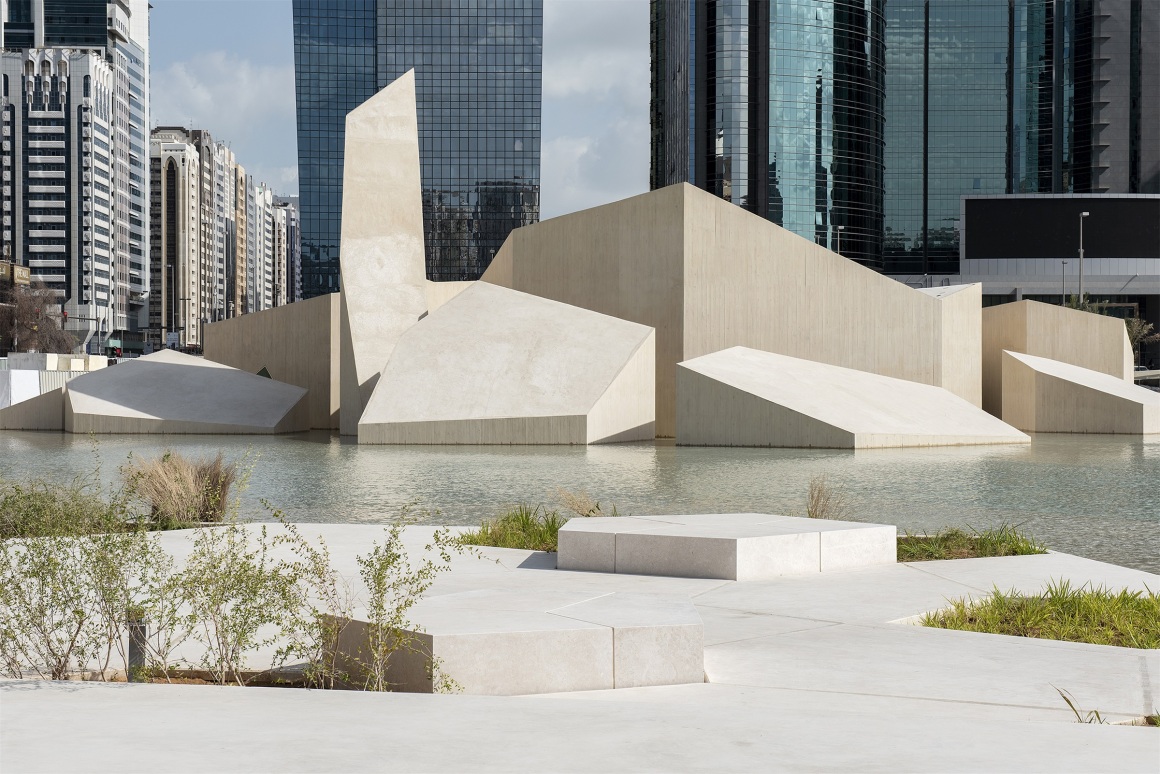
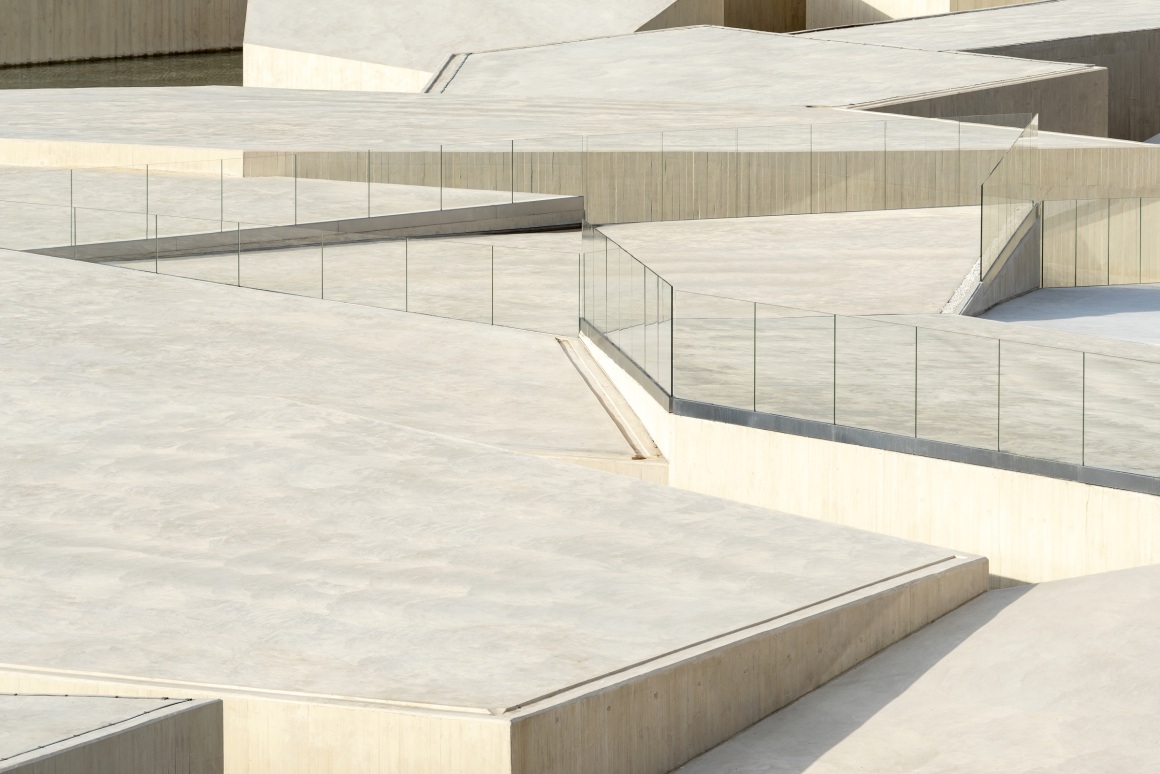
自然景观和现代建筑的兼顾 BOTH LANDSCAPE AND BUILDINGS
城市景观的几何形状兼顾了现代建筑和自然景观的特色,混凝土的色调与天然沙子的颜色相匹配。整体景观沿着改造区域从水平面向斜面过渡,带有餐饮设施和配套设施的功能性建筑逐渐显现,场地的东北角还有一个Musallah祈祷大厅。
The geometries of the urban landscape intentionally land somewhere between building and landscape, with the tone of the concrete matching the colour of the natural sand. Along the transitional zone, the landscape changes from horizontal planes to slanting surfaces that gradually grow into actual buildings for food and beverage facilities, ancillary functions, and culminating with a Musallah prayer hall at the north-eastern corner of the site.
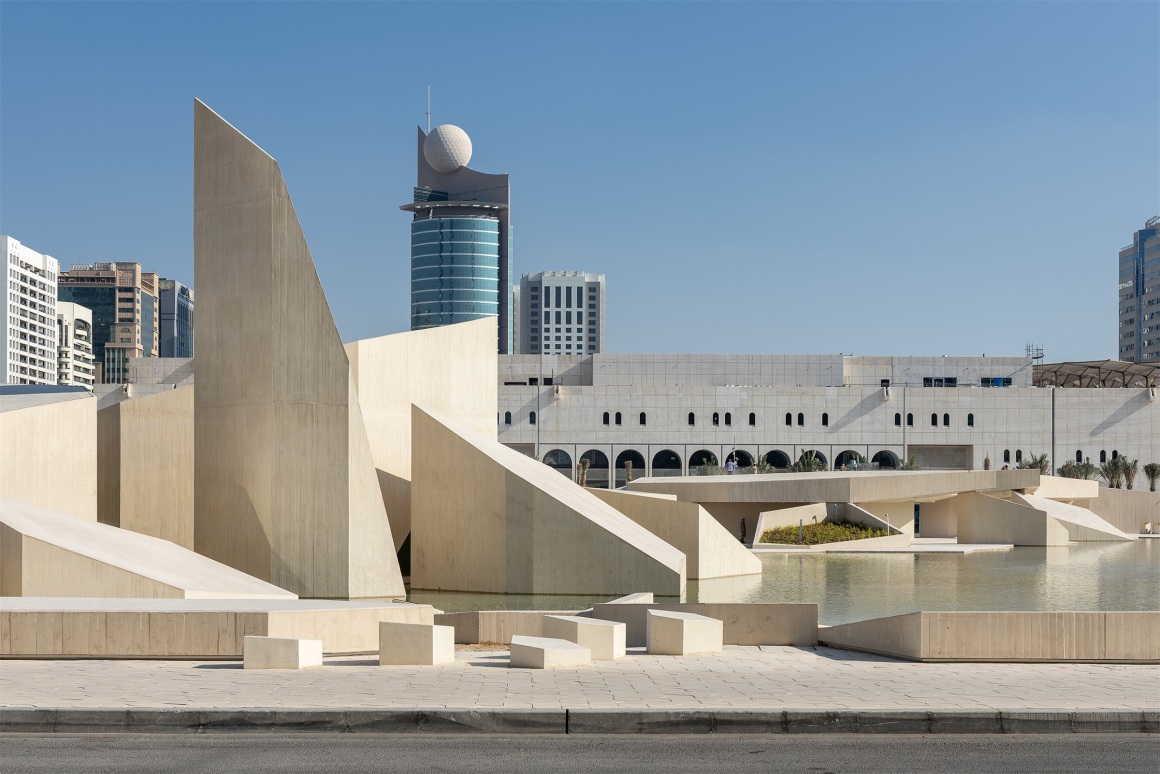
所有的场地细节——从坐柱、表面图案、照明概念、建筑体量到室内平面图、门道和家具——都巧妙地融入到整体的城市景观地形中,并与公园融为一体,成为体验性的自然景观元素。因此,景观强调了古堡和文化基金会作为主要的视觉锚点的地位。
All components – from sitting bollards, surface patterns, lighting concept, and building volumes to the interior’s floor plans, doorways, and furnishings – are subtly integrated into the overall urban landscape topography and merge with the park to be experienced as natural landscape elements. Thus, the landscape emphasises the Fort and the Cultural Foundation as the main visual anchors.
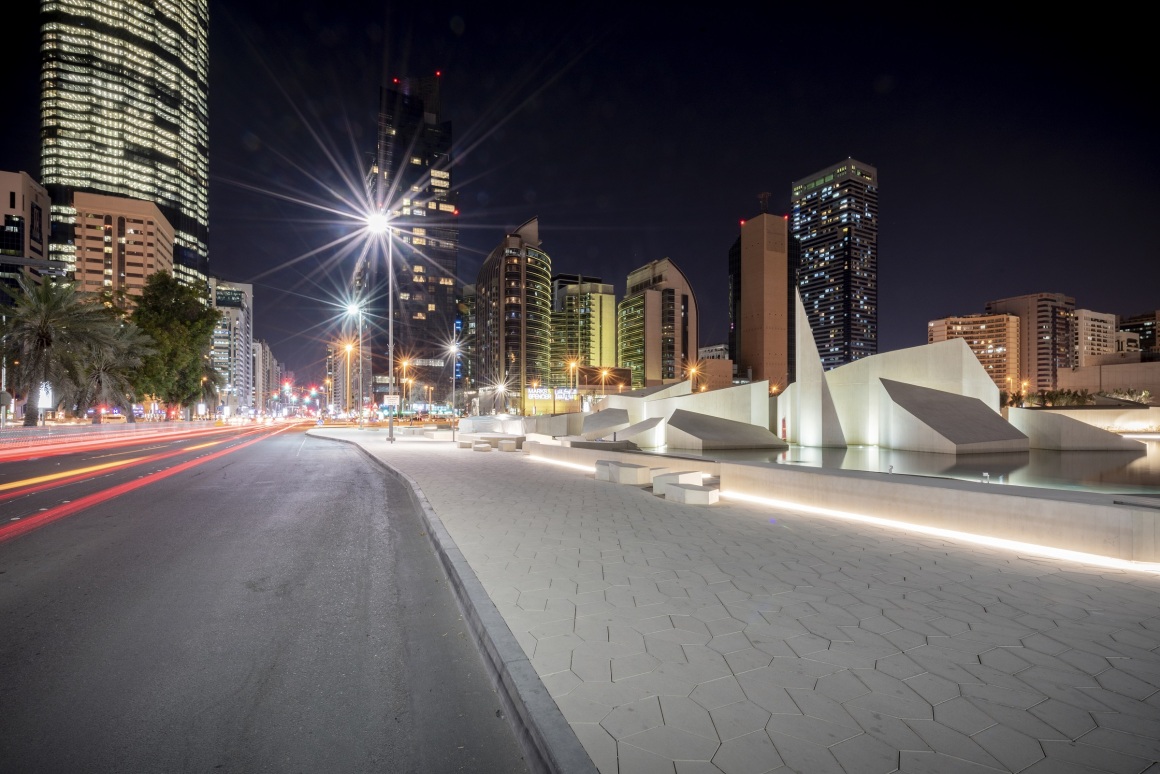
水是项目景观设计的自然焦点,这既是因为它的文化意义,也是因为它是整体设计语言中的一个综合元素,以及微气候中的自然冷却元素,据此提出种植低用水量的本地沙漠植物和使用当地的灰水浇灌公园植物以减少用水量的解决方案。公园景观的中心区域整合了一系列从南到北的水景,打破了独特的路面不规则几何形状,如狭窄的小溪、运河、溪流和地下通道,转变为穆斯林祈祷大厅周围的大型水景。
Water constitutes a natural focal point in the design of the Al Hosn landscape – both for its cultural significance, as an integrated element in the overall design narrative, as a natural cooling element for the project’s microclimate, and to present solutions for minimizing water consumption within the public park – i.e., by using native desert plants with low water consumption and to use grey wastewater from the local area when watering the park. The park-scape’s central zone integrates a series of water features that run from south to north, breaking out of the distinctive pavement’s irregular geometries as narrow creeks, canals, streams, and underground passages that transform into large water feature around the Musallah prayer hall.

传统的绿色城市公园需要全面的灌溉和维护,而在沙漠气候下,该项目意在创建一个具有当地特色的公园,所以选用了当地材料和本土、耐寒、耐阳光、只需少量灌溉的植物。
Instead of landscaping a traditional urban park of lush vegetation that would require comprehensive irrigation and maintenance in a desert climate, the project aims at creating a locally anchored park aesthetic characterized by the use of local materials and indigenous, hardy, sun tolerant plants that require minimal irrigation.

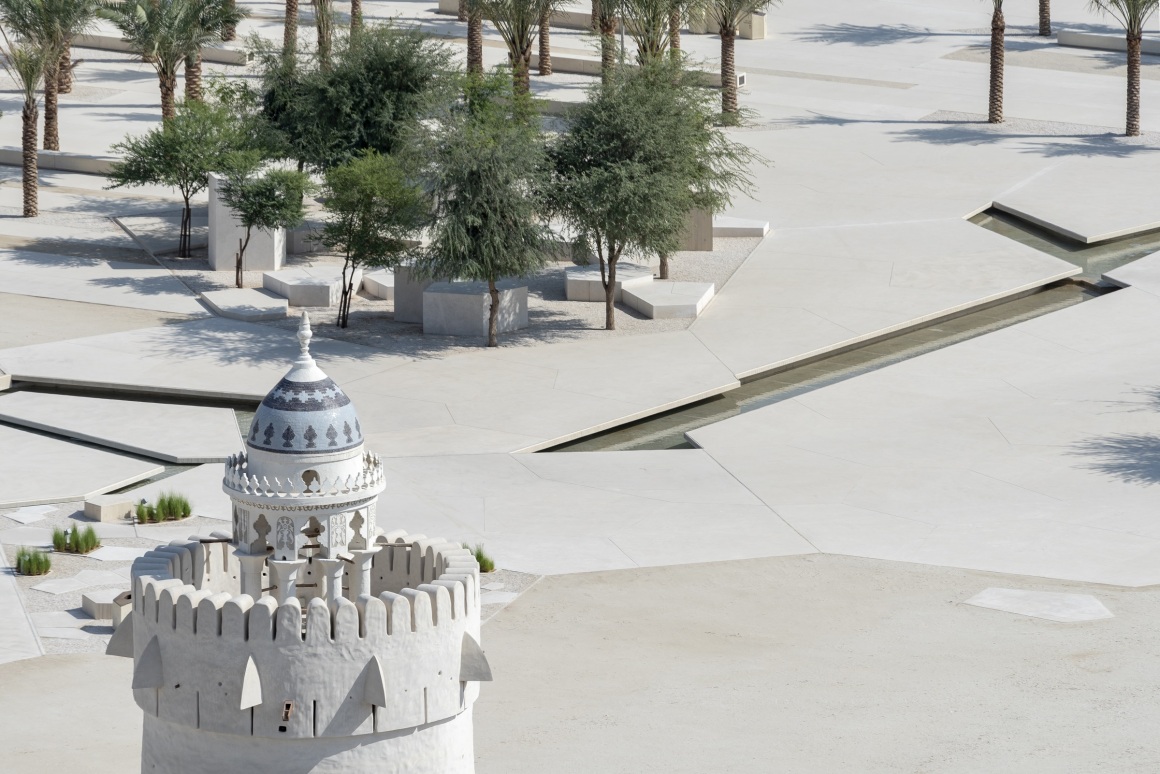
公共生活的动力来源 A DYNAMO FOR PUBLIC LIFE
埃尔霍森通过将场地小径与相邻功能区域和更广阔的城市肌理交织在一起,引入了一条有意义的城市动线,从而促进行人流通并为公共生活提供动力。公园的植被沿着道路和口袋空间为行人提供遮荫,此外,倾斜的大面积悬挑形成了餐饮区域,水景也为户外活动营造了舒适的气候,使户外空间摆脱对人工空调的依赖。
The Al Hosn site introduces a meaningful flow through the city by interweaving paths across the site with the adjacent functions and the wider urban fabric, thereby promoting pedestrianism and acting as a dynamo for public life. This is supported by the park’s vegetation, which provides shade along the pathways and pocket spaces. Also, large overhangs created by the landscape’s slanting surfaces form the food and beverage buildings along with the water feature, which supports a comfortable climate for outdoor activities independent from artificial air-conditioning.
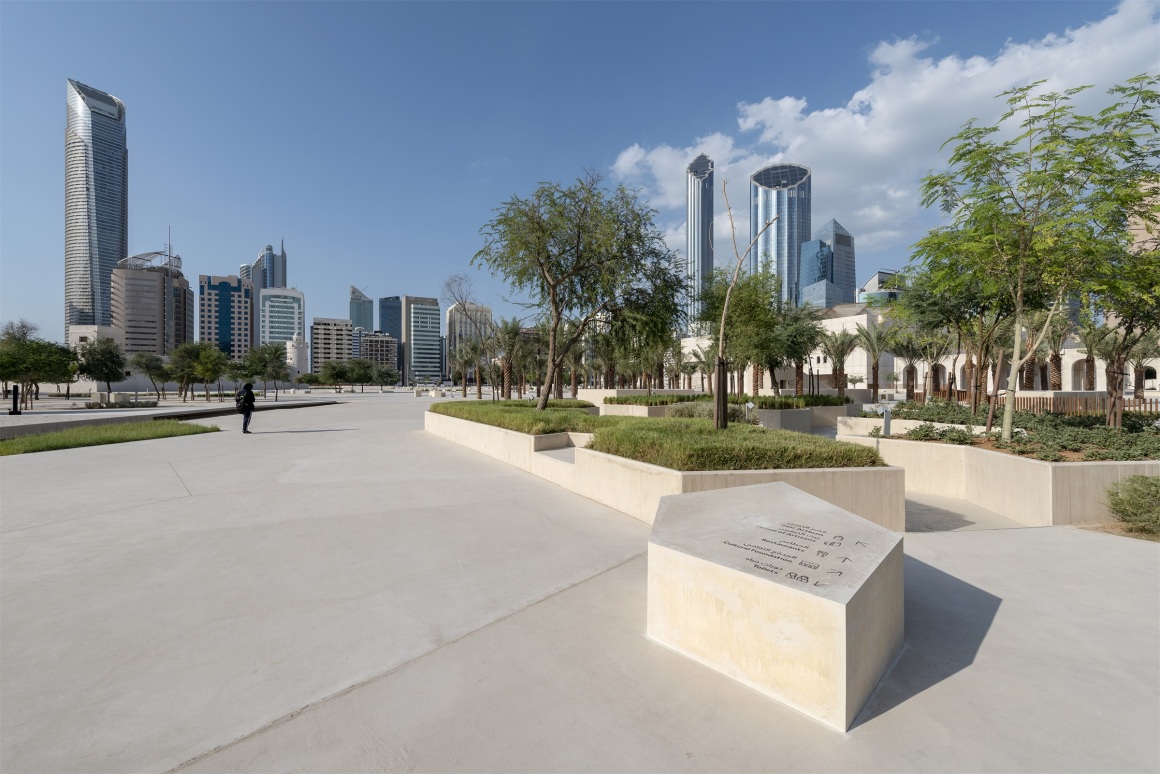
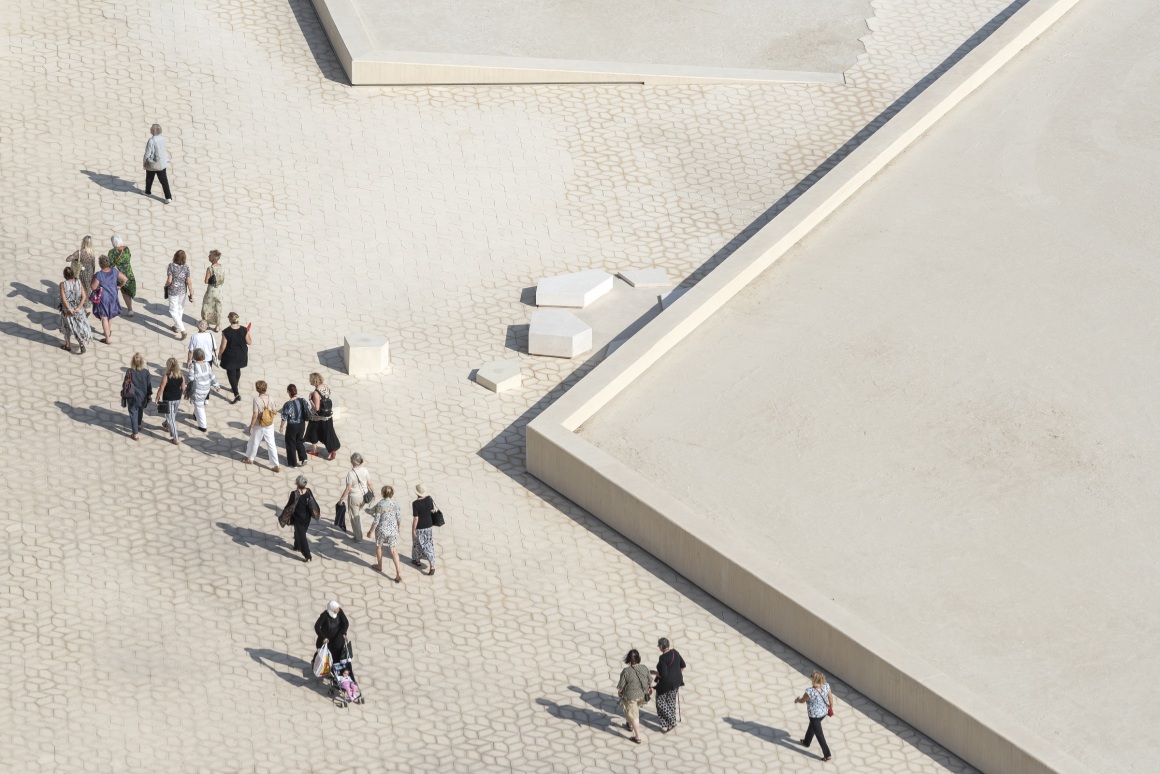
该项目在 CEBRA 与阿布扎比文化和旅游部(DCT Abu Dhabi)的紧密合作下不断推进并最终落成。
The project is developed in close collaboration with The Department of Culture and Tourism – Abu Dhabi (DCT Abu Dhabi)
▼平面图 Plan
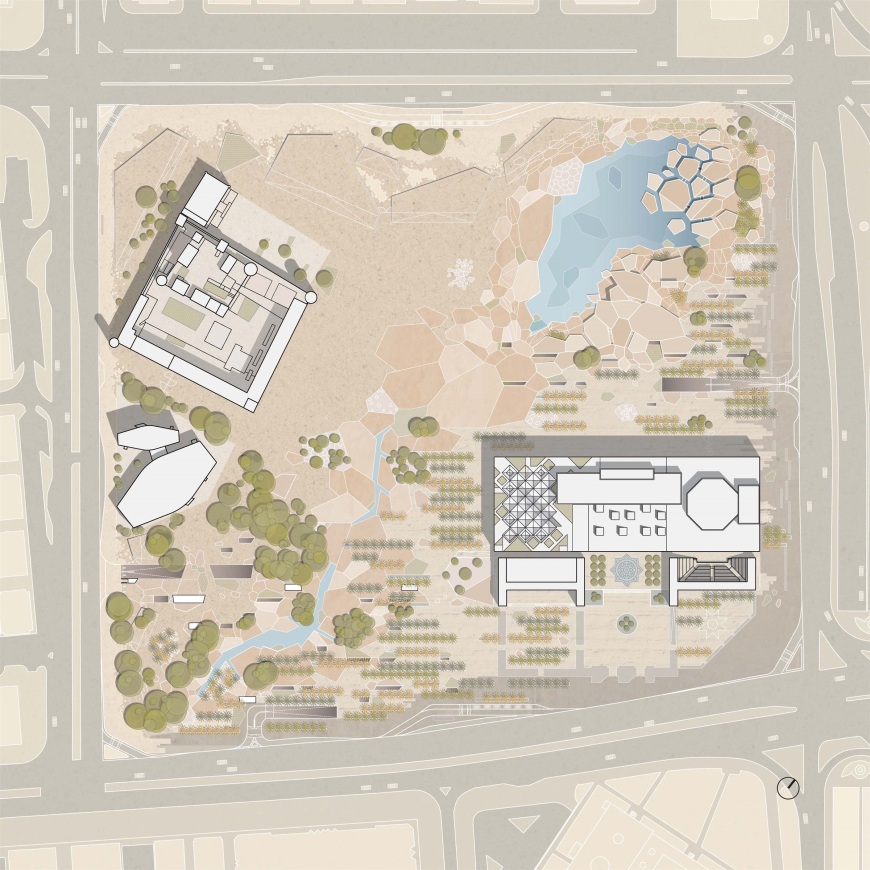
项目地点:阿拉伯联合酋长国,阿布扎比
客户:阿布扎比文化和旅游部(DCT Abu Dhabi)
面积:140,000M²
状态:已完成
建筑设计:CEBRA
景观设计:CEBRA
植物专家:SLA
工程师:GHD
保护专家:Elgaard Architecture
导向标识:Kossmann.Dejong
Location: Abu Dhabi, UAE
Client: Department of Culture and Tourism – Abu Dhabi (DCT Abu Dhabi)
Size: 140,000 M²
Status: Completed
Architect: CEBRA
Landscape architect: CEBRA
Plant Specialist: SLA
Engineer: GHD
Conservation specialist: Elgaard Architecture
Signage and wayfinding: Kossmann.Dejong
“该项目自然景观和现代建筑风格的融合,尊重和保护历史的同时为现代化”
审稿编辑:gentlebeats
更多 Read more about:CEBRA Architecture




0 Comments